Published: 3 December 2021
Turn in the birth rate was especially visible among persons aged over 30 and highly educated
According to Statistics Finland's data on population changes, the birth rate rose slightly in 2020, from 1.35 to 1.37 children per woman. The change in the birth rate was particularly visible for women aged 30 to 39, whose fertility grew most. Women's total fertility rate rose only among highly educated, but among men there was an increase in all educational groups.
Among women the birth rate turned upwards only among tertiary educated
In 2020, the birth rate of highly educated women started to rise after a prolonged decline. The birth rate of highly educated women has last risen in 2008.
The birth rate continued to decline for women with lower than tertiary level education. However, there was only a very slight fall in the upper secondary level. The fall was also somewhat smaller among those with only basic level education than in the year before.
Total fertility rate of women born in Finland by level of education in 2006 to 2020
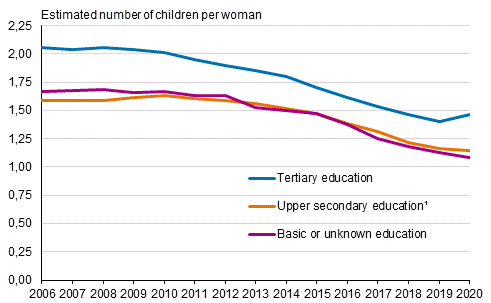
1. Includes post-secondary non-tertiary education.
The data here concern only mothers and fathers born in Finland. Some qualifications completed abroad are missing from Statistics Finland's Register of Completed Education and Degrees, for which reason the qualification data of many persons born abroad are deficient.
In 2020, the upward turn in the birth rate appears to be different in men's educational groups than women's. For men, the birth rate has turned upwards in all three educational groups (Appendix figure 1).
Children were born most to women aged 30 to 34
The birth rate rose last year most in the age groups aged 30 and over, that is, among those with the highest fertility rate before the decline in the birth rate in the 2010s. For example, the strong rise in fertility for those aged under 25 would have been divergent due to the prolonged increase in the age of family formation. In 2020, the fertility rate rose most in relative terms for those aged 30 to 34, by four per cent. The share of this age group in the total birth rate is also biggest, 35 per cent in 2020. The risen birth rate last year was also explained by the higher fertility rate among persons aged 25 to 29 and 35 to 44.
The fertility rate of persons aged under 25 continued to decline. Its share of the total birth rate has decreased to 13 per cent in 2020, while it was 17 per cent in 2010 and 21 per cent in 2000. With the gradual rise in the age at which children are had, the fertility trend of those aged 35 to 39 and 40 to 44 has been rising for a long time. The share of those aged 35 to 39 in the total birth rate is already nearly one fifth and together with those aged 40 to 44 as high as close on one quarter.
Fertility by age group in 1965 to 2020
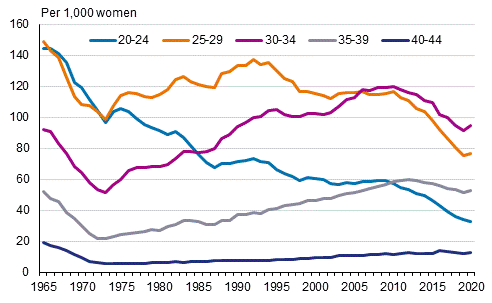
Smaller share of children than before born to married parents
The share of children born to married parents diminished rapidly in the 1990s, after which the share has declined further but at a slower pace. In 2020, altogether 54 per cent of all children were born to married parents, while in 1990 this share was 75 per cent.
Live births in and outside marriage in 1990 to 2020, per cent
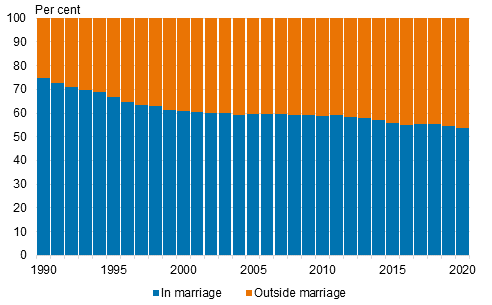
Examined by the order of the child born, it can be seen that more than one-half of first-born children are born outside marriage. In 2020, the percentage of persons born outside marriage was 57, in 1990 it was still 38. The trend of children born outside marriage is also rising when looking at those born as second-born or at least third-born children. However, the growth in the share of children born outside marriage as second-born or at least third-born has accelerated more clearly in the 2010s. This trend can be interpreted as the significance of being married at the time of birth of a child having fallen for later children of the family as well.
A majority of children born outside marriage are born to cohabiting parents. This is indicated by that in nearly nine cases out of ten children born outside marriage the mother and father of the child lived together.
Live births outside marriage by birth order in 1990 to 2020, per cent
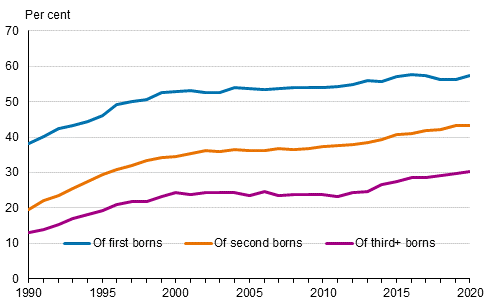
Only little differences between Nordic countries in the age of becoming a mother, Iceland excluded
By 2016, first-time mothers in Finland and Norway had reached the average age of first-time mothers in Sweden and Denmark. Since then no major differences have developed between the countries, but by 2020 the average ages again differ somewhat from each other.
In Iceland, the first child has for a long time been born to younger parents than in the other Nordic countries. However, the start of parenthood has also been delayed in Iceland, in recent years even faster than in other Nordic countries. As a result, first-time mothers in 2020 were, on average, only good one year younger in Iceland than elsewhere in the Nordic countries.
The average age of first-time fathers differs more clearly between the countries than that of mothers. The average age of becoming a father in 2020 still has clear country-specific differences. The average age of fathers was 31.6 years in Finland and 30.7 years in Iceland in 2020.
In all Nordic countries the average age of first-time fathers is around two years higher than that of first-time mothers.
Share of persons with Finnish background in the birth rate did not decrease any more
Measured by the total fertility rate, the share of women with Finnish background in the birth rate remained unchanged in 2020, 85 per cent. The total fertility rate for the whole country was 1.37 children per woman, of which the share of women with Finnish background was 1.16 children per woman. In 2010, the total fertility rate for the whole country was 1.87 children per woman, of which 1.72 were of Finnish background. This corresponded to 92 per cent of the birth rate in the whole country.
Total fertility rate broken down by mother's origin in 1990 to 2020
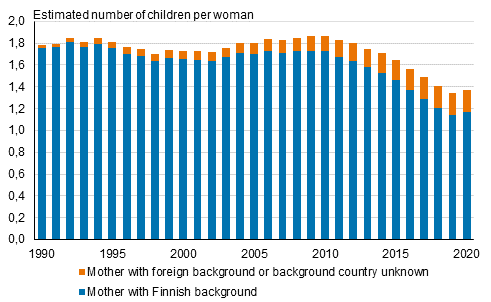
The share of persons with foreign background in the birth rate of the whole country has increased slowly from the 1990s and is currently 15 per cent of the whole country’s birth rate. In the corresponding time, the share of women with foreign background in all women aged 15 to 49 has, however, grown slightly more slowly and is slightly over 11 per cent at the end of 2020. The growth in the number of women with foreign background has been big, from close on 10,000 in 1990 to around 126,000 in 2020.
Further information about the birth rate according to origin is available on Statistics Finland's Immigrants and integration thematic pages in the section Birth rate .
Birth rate of Finnish-speaking persons rose slightly in 2020 — the birth rate of Swedish-speaking persons still higher
Since 2006, the birth rate of Swedish-speaking persons has been slightly higher than that of Finnish-speaking persons. In the last decade, the birth rate has fallen in both language groups, but in 2020, the total fertility rate of Finnish speakers rose from 1.29 to 1.32 children per woman. In 2020, the total fertility rate of Swedish-speaking persons was ever higher, 1.51 children per woman. The total fertility rate was 1.95 for Swedish-speaking persons and 1.85 for Finnish-speaking persons in 2010.
Total fertility rate of FInnish-speaking and Swedish-speaking women in 1991 to 2020
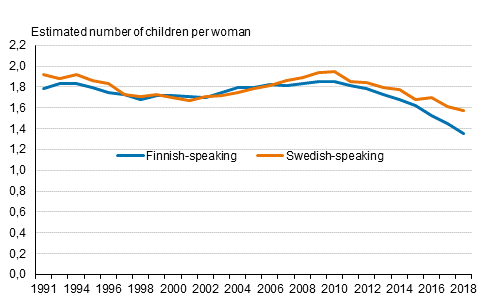
Source: Births 2020. Statistics Finland
Inquiries: Juhana Nordberg 029 551 3051, Timo Nikander , info@stat.fi
Head of Department in charge: Hannele Orjala
Publication in pdf-format (304.0 kB)
- Tables
-
Tables in databases
Pick the data you need into tables, view the data as graphs, or download the data for your use.
Appendix tables
- Figures
- Quality descriptions
-
- Quality description, births 2020 (3.12.2021)
Updated 03.12.2021
Official Statistics of Finland (OSF):
Births [e-publication].
ISSN=1798-2413. 02 2020. Helsinki: Statistics Finland [referred: 15.12.2025].
Access method: http://stat.fi/til/synt/2020/02/synt_2020_02_2021-12-03_tie_001_en.html

